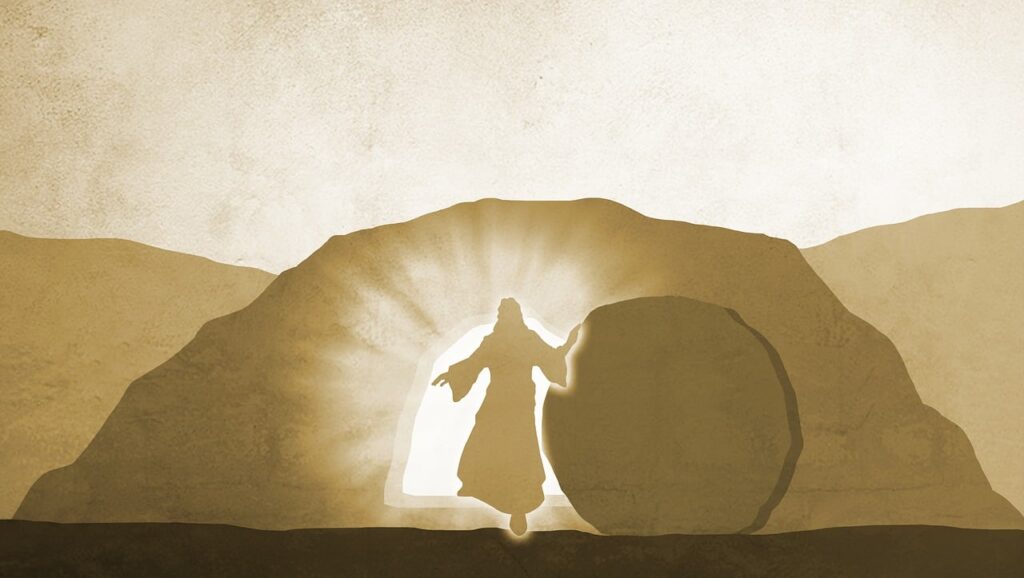The resurrection of Jesus Christ stands as the cornerstone of the Christian faith. It is the most significant event in human history, marking the triumph of life over Death, hope over despair, and redemption from sin. This divine act of power validated Jesus’ identity as the Son of God and inaugurated a new era for humanity. The Church, especially in the tradition of the Church of Pentecost, upholds the resurrection as a fundamental doctrine. One of its chief responsibilities is to proclaim the Death, burial, and resurrection of Jesus Christ to all nations, echoing the spirit of Peter’s sermon on the Day of Pentecost in Acts 2:22-33: “Fellow Israelites, listen to this: Jesus of Nazareth was a man accredited by God to you by miracles, wonders, and signs, which God did among you through him, as you yourselves know. 23 This man was handed over to you by God’s deliberate plan and foreknowledge, and you, with the help of wicked men, put him to Death by nailing him to the cross. 24 But God raised him from the dead, freeing him from the agony of Death, because Death could not keep its hold on him. 25 David said about him:
“‘I saw the Lord always before me.
Because he is on my right hand,
I will not be shaken.
26 Therefore, my heart is glad, and my tongue rejoices;
My body also will rest in hope.
27 because you will not abandon me to the realm of the dead,
You will not let your holy one see decay.
28 You have made known to me the paths of life;
You will fill me with joy in your presence.’
29 “Fellow Israelites, I can tell you confidently that the patriarch David died and was buried, and his tomb is here to this day. 30 But he was a prophet and knew God had promised him on oath to place one of his descendants on his throne. 31 He foretold the Messiah’s resurrection, saying he was not left to Death or decay. 32 God has raised this Jesus to life, and we all witness it. 33 Exalted to the right hand of God, he has received from the Father the promised Holy Spirit and has poured out what you now see and hear.
Prophetic Foundations of the Resurrection
The resurrection was not an unexpected turn of events but a fulfillment of ancient prophecies. The Old Testament contains profound foreshadowings of Christ’s resurrection. Psalm 16:10 declares, “For You will not leave my soul in Sheol, nor will You allow Your Holy One to see corruption.” This verse prophetically pointed to the Messiah, whose body would not decay in the grave.
Isaiah 53:5-12 presents a vivid picture of the suffering servant who would die for the sins of many. Verse 10 proclaims, “When You make His soul an offering for sin… He shall prolong His days,” signifying resurrection after Death. Hosea 6:2 echoes this theme: “After two days He will revive us; on the third day He will raise us, that we may live in His sight.”
Even Jonah’s three days and nights in the belly of the enormous fish (Jonah 1:17) foreshadowed Christ’s burial and resurrection, as Jesus Himself testified in Matthew 12:40.
The Death of the Lord Jesus Christ
Jesus’ crucifixion was the culmination of His earthly ministry. Each Gospel writer records the moment of His Death with solemn reverence. Matthew 27:45–54 tells of darkness over the land, the temple veil tearing in two, and the earth quaking—a cosmic response to the Death of the Son of God. Mark 15:33-39 notes Jesus crying out and giving up His spirit. Luke 23:44-49 emphasizes the awe of the centurion who declared, “Certainly this was a righteous Man!” In John 19:28-37, Jesus proclaims, “It is finished,” fulfilling the Scriptures and completing His redemptive mission.
The Resurrection Morning
The resurrection narrative bursts forth with light and life. Matthew 28:1-10 recounts the angel’s proclamation to the women at the tomb: “He is not here; for He is risen, as He said.” Mark 16:18 affirms, “He is risen! He is not here.” Luke 24:1-12 delivers the angelic rebuke: “Why do you seek the living among the dead? He is not here but has risen!” John 20:1-18 recounts Mary Magdalene’s encounter with the risen Lord, as He calls her by name.
These appearances confirm the truth of the resurrection and the personal nature of Jesus’ relationship with His followers. His victory over Death was not abstract—it was intimate and transformative.
Post-Resurrection Appearances
The risen Christ did not remain hidden. He appeared to His followers on many occasions. Luke 24:13-35 recounts His conversation with two disciples on the road to Emmaus. Luke 24:36-49 and John 20:19-29 show Jesus revealing Himself to the disciples, including doubting Thomas. John 21:1–14 describes His appearance by the Sea of Tiberias, where He shares a meal with His disciples.
Acts 1:3 summarizes, “To whom He also presented Himself alive after His suffering by many infallible proofs, being seen by them during forty days and speaking of the things about the kingdom of God.”
Peter’s Pentecost Sermon and the Church’s Mandate
Peter stood with the eleven on the Day of Pentecost and boldly proclaimed the resurrection. In Acts 2, he declares that Jesus, whom they crucified, has been raised by God and exalted. Quoting Psalm 16:10, Peter explains that David spoke of the resurrection of the Messiah: “His soul was not left in Hades, nor did His flesh see corruption.” (Acts 2:31)
This sermon converted 3,000 souls, birthing the New Testament Church. The resurrection was the central message that the Church must continue to preach.
Theological Significance of the Resurrection
The resurrection is more than a historical event; it is the bedrock of Christian doctrine. Romans 4:25 states, “Who was delivered up because of our offenses and raised because of our justification.” Without the resurrection, there is no justification—no right standing with God.
Romans 6:45 explains that believers are united with Christ in His Death and resurrection: “Even so, we also should walk in newness of life.” His resurrection makes our spiritual rebirth possible.
In 1 Corinthians 15, Paul articulates the importance of this doctrine. Verses 3–8 lay out the gospel: “Christ died for our sins… was buried… rose again on the third day… and was seen.” Verses 12–22 affirm that our faith is futile if Christ is not risen. But “now Christ is risen from the dead… For as in Adam all die, even in Christ all shall be made alive.”
This chapter describes the resurrection body, the eventual victory over Death, and believers’ assurance of eternal life (1 Corinthians 15:42-57).
In Philippians 3:10-11, Paul expresses a desire to know Christ and intimately experience the power of His resurrection, emphasizing that this power is to be felt and lived rather than merely understood intellectually.
1 Peter 1:3 praises God for “a living hope through the resurrection of Jesus Christ from the dead.” This hope is not wishful thinking—it is a confident assurance based on a risen Savior.
The Believer’s Hope and Responsibility
The resurrection assures believers of their future resurrection. It empowers them for holy living. 2 Corinthians 5:15 states, “He died for all, that those who live should live no longer for themselves, but for Him who died for them and rose again.” The resurrection calls us to a life of purpose and devotion.
1 Thessalonians 4:14 provides comfort: “For if we believe Jesus died and rose again, even so, God will bring with Him those who sleep in Jesus.” Death has lost its sting for the believer.
Hebrews 13:20 calls God “the God of peace who brought up our Lord Jesus from the dead,” affirming divine authority over life and Death. Revelation 1:17-18 offers this triumphant declaration from the risen Christ: “I am He who lives, and was dead, and behold, I am alive forevermore. Amen. And I have the keys of Hades and of Death.”
A Call to the Church of Today
As Peter did on the Day of Pentecost, the Church today must boldly proclaim the message of the resurrection. This message transcends the confines of a seasonal Easter sermon; it embodies the very essence of the gospel and the transformative power of salvation available to all who believe. The resurrection story must resonate through the ages, echoing across every generation, enriching every culture, and illuminating every nation.
The Church of Pentecost holds this as a foundational truth. Just as the early apostles were witnesses of His resurrection (Acts 1:22), so too is the Church commissioned to be His witnesses “to the ends of the earth” (Acts 1:8).
Jesus Christ is alive. His resurrection validates His deity, guarantees our salvation, and offers hope of eternal life. Let us, therefore, echo the angel’s declaration with joy and conviction: “He is not here; for He is risen, as He said.”
May the Church never cease to declare: Christ is risen! He is risen indeed!

